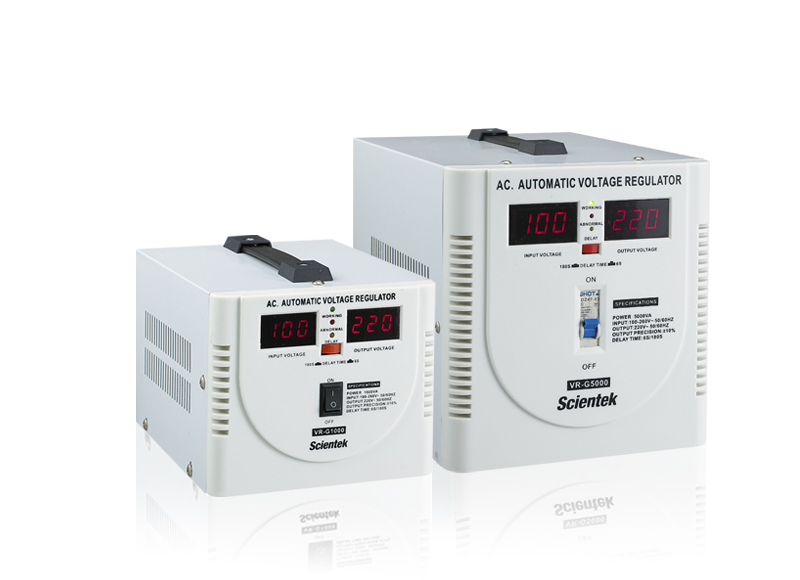UPS power supply is divided into online UPS power supply and backup UPS power supply. Generally, home computers are equipped with backup UPS power supply, which is a kind of backup power supply; the backup type is with a voltage regulator part, and the relay is used for replacement. The voltage stabilizing method is very poor and cannot be regarded as a stabilizing device.
The UPS power supply is like an emergency power supply. It can be connected to the mains and act as an AC mains voltage stabilizer, and it also charges the internal battery(DC to AC power converter). When the utility power is interrupted, the UPS will continue to supply 220V AC power to the load through the method of inverter conversion of the electric energy of the battery in the machine to ensure that the server in the computer room will not be powered off. It is actually a reserve power supply. When a power failure occurs, the energy stored in the battery will be converted and output AC current to power the equipment. Generally, the time interval for switching from the host to the backup power supply does not exceed 10 milliseconds, so the power failure is almost never Will have any impact on electrical equipment.

The voltage stabilizer is composed of a voltage regulating circuit, a control circuit, and a servo motor. When the input voltage or load changes, the control circuit samples, compares, and amplifies, and then drives the servo motor to rotate to change the position of the carbon brush of the voltage regulator. The coil turns ratio is automatically adjusted to keep the output voltage stable. It is designed for the instability of the grid voltage, mainly for the protection of back-end equipment, and has a relatively complete protection function for the equipment. Generally, large UPS power supplies must also be equipped with a regulated bypass system (voltage stabilizer), which has a wide range of functions, and can be used almost where electricity is needed (of course, the premise is that the voltage is unstable).
The stabilized power supply cannot provide backup power for the server when the mains power is interrupted. It is only designed for voltage instability. It is mainly used to protect back-end equipment and has a more complete protection function for equipment. In the case of unstable voltage, high and low voltage, you can use a regulated power supply, but it will not supply power to the server. The stabilized power supply is mainly used to stabilize the voltage, to provide a stable electricity environment for the electric equipment, and to avoid the voltage fluctuation or interference with the electric equipment. Because the function is completely different from the UPS power supply, and the UPS power supply also comes with an energy storage battery, the price and cost are relatively high. When the power comes on again after a power failure, you can delay 5-8 minutes to start the output power to avoid damage to the electrical appliances due to excessive voltage. Be sure to pay attention to the completeness of the above three basic functions when purchasing a household regulator.
The voltage stabilizer only stabilizes the voltage; the UPS can not only stabilize the voltage, but also can continue to supply power by the battery inverter after a power failure to ensure that the equipment does not lose power. Regulated power supply, which is what we call voltage stabilizer, is a completely different set of concepts from UPS power supply. It is not only the function, but the structure or principle is not a concept at all. Because some of the better quality backup UPS power supplies do come with a voltage regulator function, which is a kind of electronic switching regulator, which can be used as a voltage regulator, but there is no special voltage regulator for the effect and accuracy of the voltage regulation. The device is ideal. So when you buy, you can choose according to your own actual situation, and you must distinguish them.
Step-down ("buck") switching voltage converters (or regulators) are commonly used in battery-powered products because they are effective over a wide voltage and load range and are relatively simple. However, when the battery voltage is lower than the required output, the regulator stops operating. This can be a disadvantage in portable designs, because after the power supply "falls out", there is usually some unused capacity left in the battery, which might otherwise be used to extend the running time.
Common solutions to address unused battery capacity are buck/boost ("buck/boost") switching regulators or alternative topologies such as single-ended primary inductance converters (SEPIC). Once the battery output is lower than the required power output, these types of power supplies will automatically switch to the boost configuration. But buck/boost devices are relatively expensive, the circuit is more complicated, and the power supply takes up more board space.
However, there are fewer options for switching power supplies that can maximize battery capacity. In portable products, simple and cheap: switching inverter regulators. These are usually used to convert a positive input voltage to a (lower) negative output, but can also be used to convert a varying positive input to a lower or higher negative output.
Switching inverting regulators can be simpler and cheaper options for buck/boost operation than traditional buck/boost devices. The disadvantage of using a switching inverting regulator in this type of application is that the output voltage is negative. However, reversing the polarity of the circuit is simple; the circuit can be designed so that the negative output is set to system ground, and the negative battery terminal then becomes the "positive" voltage source.